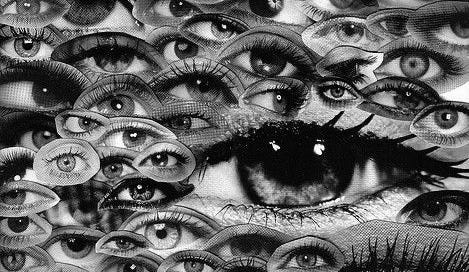the middle’s gone. now what?
Why compression culture flattened the spectrum—and made mimicry the norm.
There used to be a middle.
Middle class. Middlebrow. Middle manager. Middle market.
It signified something coherent: stability, legibility, a shared set of expectations. Not exciting, but usable. A social framework that helped you orient yourself.
That framework is gone.
The middle didn’t explode—it eroded. Quietly, then all at once. Not with chaos, but with compression: the flattening of economic categories, aesthetic codes, and cultural signals into a single, overloaded interface.
identity as performance
When the center disappears, identity loses its fixed shape. Without a common script, people write themselves in fragments. Selfhood becomes a construction—performed rather than possessed.
The result is aesthetic layering: part skater, part finance-core, part New Age minimalism. A CEO in Arc’teryx. A 22-year-old in Bottega. A bedroom pop artist styled like a Berlin architect. Everyone pulling references from everywhere.
There’s no contradiction in this, because contradiction is now the aesthetic. Culture has stopped asking for coherence. It asks instead for fluency.
compression flattened the spectrum
This is the compression zone.
Where elite and mass aesthetics coexist in the same scroll. Where subcultures don’t develop—they get moodboarded. Where the algorithm favors familiarity with a twist: “clean girl,” “trad wife,” “stealth wealth,” “whatever DIY.” What once would have been opposing style codes are now just tags on the same platform. You don’t choose one—you cycle through all of them.
What matters isn’t depth. It’s velocity. Referencing is how you signal competence in a culture that updates faster than it can stabilize.
copying is the new creativity
This isn’t a glitch in the system—it is the system.
In a media environment defined by speed and saturation, originality becomes inefficient. Referencing becomes the primary creative act.
Fredric Jameson called it “the waning of affect”—the replacement of emotion with citation (1991). Pierre Bourdieu would frame it as aesthetic capital in motion: the ability to navigate taste cultures as a form of social power (1984).
To put it more plainly: we don’t create from nothing anymore. We copy, combine, and contextualize. Creativity becomes curatorial. The logic of copying isn’t just survival—it’s strategy. Mimicry gains traction. The archetype dissolves. A new signal emerges. The cycle repeats.
Success is no longer about doing it first—it’s about doing it recognizably. The best copies aren’t derivative; they’re legible. The loop is the logic.
As Ana Andjelic writes, brands now operate with “liquidity”—absorbing trends fast enough to stay relevant without being pinned down (2024). Cultural capital comes from agility, not authority.
when compression becomes cosplay
The aesthetic mix isn’t ironic. It’s normalized. The head of product in trail runners. The DJ in leather pants and a Patagonia vest. The technologist dressed like a conceptual artist. It’s not that people are pretending—it’s that the performance is the person.
Style has become speculative. An exercise in temporary alignment. What used to be identity is now projection.
We are not crafting authenticity. We are sampling its visual signals. It’s not just individuals. Institutions have learned to mimic just as fluidly. Glossier recontextualized the pharmacy aisle as intimacy. Aritzia borrowed from Calvin Klein and filtered it through mid-tier aspiration. Erewhon rebranded the corner store as lifestyle infrastructure—with adaptogens.
None of these are original moves. They are repositionings. Cultural references, reassembled. Identity as an aesthetic product. In a compressed landscape, the brand doesn’t have to mean anything fixed. It just needs to feel relevant, briefly.
to survive the scroll
The middle is gone. The shared reference points have scattered.
What’s left is a feed of gestures. And inside that, we copy—not because we lack ideas, but because copying is the language now. It’s how we translate ourselves across infinite interfaces.
We copy to keep up. To be seen. To stay within signal range.
We used to create to express. Now we copy to belong. To navigate. To circulate. And to survive the compression, we do it well.
Still, every act of mimicry contains a decision.
Are you mirroring the moment—or manipulating it?
references
Andjelic, A. (2024). Hitmakers: How Brands Create Cultural Relevance. PublicAffairs.
Jameson, F. (1991). Postmodernism, or, the Cultural Logic of Late Capitalism. Duke University Press.
Bourdieu, P. (1984). Distinction: A Social Critique of the Judgement of Taste. Harvard University Press.
Genz, S. (2015). Postfeminism and Popular Culture: Feminism and Femininity in the 21st Century. Palgrave Macmillan.
Wipperfürth, A. (2005). Brand Hijack: Marketing Without Marketing. Portfolio.
Zwick, D., & Cayla, J. (2021). Branding without Brands. Journal of Consumer Research, 48(5), 856–875. https://doi.org/10.1093/jcr/ucab032





This is a great read, lots to think about here!! I wonder if the idea of "basic" is part of this flattening (ironically). When the common script / the middle became something to mock and laugh at, did that push people towards specific aesthetics to show personality and cachet?